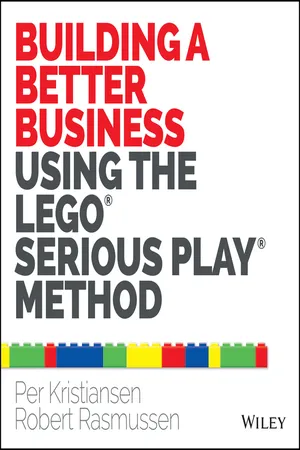
Building a Better Business Using the Lego Serious Play Method
- English
- ePUB (mobile friendly)
- Available on iOS & Android
Building a Better Business Using the Lego Serious Play Method
About this book
Unleash innovation potential with creative, serious play
Building a Better Business Using the LEGO® SERIOUS PLAY® Method delivers a creative approach to enhancing innovation and improving business performance, with the focus on unleashing play. Written by the two original Master Trainers for LEGO SERIOUS PLAY (LSP), the book outlines how LSP can develop teams, people, relationships and business. Based on the merging of play with organizational development, systems thinking and strategy development, LSP can foster improved meetings, faster innovation processes, team growth, and better communication.
The belief that everyone intends to "do good" and has the potential to do it is at the heart of LSP. The method nurtures the idea that everyone in an organization can contribute to discussions and outcomes. Building with LEGO bricks is a type of creative play that triggers a different kind of thought process, unleashing imagination and potential that is frequently untapped by the logical mind. The book explains this hands-on, minds-on approach, and discusses the theory as well as the practical implementation of LSP. Topics include:
- Observation of internal and external interaction dynamics
- Fostering a free and honest exchange of opinions
- Suspending hierarchy for better, more effective communication
- Facilitating change by encouraging exploration
The LEGO SERIOUS PLAY method is employed by start-ups and multinational corporations alike to maximize synergy among teams and throughout organizations. For leaders looking to boost effectiveness and see better results, Building a Better Business Using the LEGO® SERIOUS PLAY® Method is a comprehensive introduction to this creative management technique.
Frequently asked questions
- Essential is ideal for learners and professionals who enjoy exploring a wide range of subjects. Access the Essential Library with 800,000+ trusted titles and best-sellers across business, personal growth, and the humanities. Includes unlimited reading time and Standard Read Aloud voice.
- Complete: Perfect for advanced learners and researchers needing full, unrestricted access. Unlock 1.4M+ books across hundreds of subjects, including academic and specialized titles. The Complete Plan also includes advanced features like Premium Read Aloud and Research Assistant.
Please note we cannot support devices running on iOS 13 and Android 7 or earlier. Learn more about using the app.
Information
Part I
The LEGO® SERIOUS PLAY® Territory
- The business needs for which the method provides a great solution, and the challenges that the method evolved to deal with
- What the LEGO brick is, the power behind it, its history, how it is used in LEGO SERIOUS PLAY, and the difference it makes
- What we mean by the term serious play
- How all of this comes together in what we define as the LEGO SERIOUS PLAY method
Chapter 1
The Need for Building Better Businesses
- Beyond 20/80 meetings and Creating leaning in
- Leading to unlock
- Breaking habitual thinking

Beyond 20/80 and Creating Leaning In

Leading in Order to Unlock
The Knowledge in the Room
Understanding the System
Table of contents
- Cover
- Title Page
- Copyright
- Preface
- Introduction—The Journey!
- Part I: The LEGO® SERIOUS PLAY® Territory
- Part II: LEGO® SERIOUS PLAY®: The Science Platform
- Part III: LEGO® SERIOUS PLAY® at Work
- About the Authors
- Index
- End User License Agreement